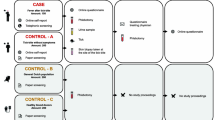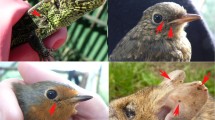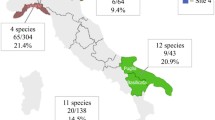Summary
Tick-borne lymphadenopathy (TIBOLA) is an emerging infection caused by Rickettsia slovaca. We describe here the seasonal, age and gender characteristics as well as the association with horse contact as risk factors for acquiring TIBOLA in comparison with another, more frequent tick-borne disease, Lyme borreliosis.
We analysed a dataset of 855 patients diagnosed with either Lyme (n = 805) or TIBOLA (n = 50) disease using Fisher’s exact tests and generalized linear models. Then we performed a matched case-control study in which all TIBOLA patients were paired with one Lyme patient matching in age and gender. We identified the species of ticks collected from the TIBOLA patients (n = 16).
We found that horse contact was significantly more frequent among TIBOLA (34/50; 68 %) than among Lyme patients (110/805; 13.7 %) (OR = 13.35, p < 0.001). The younger age and female gender associated with higher risk of acquiring TIBOLA (OR = 3.99, p < 0.001). Ten of the 16 ticks were D. marginatus, six were D. reticulatus suggesting that both species are responsible for transmitting R. slovaca. Two patients acquired the infection from male ticks. TIBOLA is a tick-borne zoonosis, which might have a specific association with horse contact.
Zusammenfassung
Die durch Zecken übertragene Lymphadenopathie (TIBOLA) ist eine durch Rickettsia slovaca verursachte Infektion. Wir beschreiben in der vorliegenden Arbeit die saisonalen, Alters- und Gechlechts-mäßigen Charakteristika, sowie den Zusammenhang mit Kontakt mit Pferden als Risikofaktor für das Auftreten von TIBOLA im Vergleich zu einer anderen – häufigeren – Zeckenerkrankung, der Lyme Borreliose.
Wir analysierten Daten von 855 Patienten, bei denen entweder eine Lyme Borreliose (n = 805) oder eine TIBOLA (n = 50) diagnostiziert worden war, wobei wir Fischer’s exakten Test oder generalisierte lineare Modelle verwendeten. Außerdem führten wir eine Alters- und Geschlechts-mäßig gematchte Fallkontrollstudie durch, bei der alle TIBOLA-Patienten mit einem im Alter und Geschlecht entsprechenden Patienten mit Lyme Borreliose verglichen wurden. Weiters identifizierten wir die Spezies der Zecken, die von den TIBOLA-Patienten gesammelt wurden (n = 16).
Wir fanden, dass der Kontakt mit Pferden bei Patienten mit TIBOLA wesentlich häufiger (34/50; 68 %) als bei Patienten mit Lyme Borreliose war (110/805; 13,7 %) (OR = 13,35, p < 0,001). Jüngeres Alter und weibliches Geschlecht waren mit einem höheren Risiko, TIBOLA zu bekommen, assoziiert (OR = 3,99, p < 0,001). Zehn der 16 Zecken waren D.marginatus, 6 waren D. reticulatus, wodurch nahe gelegt wird, dass beide Spezies für die Übertragung von R. slovaca verantwortlich sind. Zwei Patienten wurden durch männliche Zecken infiziert. TIBOLA ist eine durch Zecken übertragene Krankheit (Zoonose), die einen spezifischen Zusammenhang mit Pferdekontakt haben könnte.


Similar content being viewed by others
References
Lakos A. Tick-borne lymphadenopathy—a new rickettsial disease? Lancet 1997;350(9083):1006.
Raoult D, Berbis P, Roux V, Xu W, Maurin M. A new tick-transmitted disease due to Rickettsia slovaca. Lancet. 1997;350(9077):112–3.
Oteo JA, Ibarra V, Blanco J. Eritema, necrosis y linfadenopatía. Una nueva enfermedad (DEBONEL) transmitida por Dermacentor marginatus Sulzer 1776. Zubia Monogr. 2000; 12:49–58.
Lakos A. Tick-borne lymphadenopathy (TIBOLA). Wien klin Wochenschr. 2002:114(13–14):648–54.
Raoult D, Lakos A, Fenollar F, Beytout J, Brouqui P, Fournier PE. Spotless Rickettsiosis caused by Rickettsia slovaca and associated with Dermacentor ticks. Clin Inf Dis. 2002;34(10):1331–6.
Fernández-Soto P, Pérez-Sánchez R, Encinas-Grandes A, Alamo Sanz R. Rickettsia slovaca in Dermacentor ticks found on humans in Spain. Eur J Clin Microbiol Infect Dis. 2006;25(2):129–31.
Arthur DR. Ticks. A monograph of the Ixodoidea. Part V. Cambridge: Cambridge University Press, 1960.
Hillyard PD. Ticks of North-West Europe. Synopses of the British fauna (New series), vol. 52, Shrewsbury: Field Studies Council, 1996.
Estrada-Peña A, Bouattour A, Camicas JL, Walker AR. Ticks of domestic animals in the Mediterranean region. A guide to identification of species. Zaragoza: University of Zaragoza, 2004.
Faraway JJ. Extending the linear model with R: generalized linear, mixed effects and nonparametric regression models. Boca Raton: Chapman & Hall/CRC, 2006.
Burnham KP, Anderson DR. Model selection and multimodel inference. New York: Springer, 2002.
R Development Core Team. R: a language and environment for statistical computing. R Foundation for Statistical Computing. Vienna, 2009. http://www.R-project.org
Therneau T. and original R port by Lumley T. Survival: survival analysis, including penalised likelihood. R package version 2.35-4, 2009. http://CRAN.R-project.org/package=survival
Lakos A, Ferenczi E, Komoly S, Granström M. Different B-cell populations are responsible for the peripheral and intrathecal antibody production in neuroborreliosis. Int Immunol. 2005;17(12):1631–7.
Janisch M. Kartographische Aufnahme der ungarischen Zeckenfauna (Geographical distribution of tick species in Hungary). Állattani Közlemények. 1959;47(1–2), 103–10.
Ibarra V, Oteo JA, Portillo A et al. Rickettsia slovaca infection: DEBONEL/TIBOLA. Ann NY Acad Sci. 2006;1078:206–14.
Porta FS, Nieto EA, Creus BF et al. Tick-borne lymphadenopathy: a new infectious disease in children. Pediatr Infect Dis J. 2008;27(7):618–22.
Lakos A, Solymosi N, Földvári G. Horses and drought as risk factors for tick-borne lymphadenopathy (TIBOLA). International congress of vector ecology. Antalya, 2009. October 7–9, pp 185–6.
Oteo JA, Ibarra V, Blanco JR et al. Dermacentor-borne necrosis erythema and lymphadenopathy: clinical and epidemiological features of a new tick-borne disease. Clin. Microbiol. Infect. 2004;10(4):327–31.
Komitova R, Lakos A, Aleksandrov A, Christova I, Murdjeva M. A case of tick-transmitted lymphadenopathy in Bulgaria associated with Rickettsia slovaca. Scand J Infect Dis. 2003;35(3):213.
Selmi M, Bertolotti L, Tomassone L, Mannelli A. Rickettsia slovaca in Dermacentor marginatus and tick-borne lymphadenopathy, Tuscany, Italy. Emerg Infect Dis. 2008;14(5), 817–20.
Rieg S, Schmoldt S, Theilacker C et al. Tick-borne lymphadenopathy (TIBOLA) acquired in Southwestern Germany. BMC Infect Dis. 2011;11:167. doi: 10.1186/1471–2334-11–167.
Sréter-Lancz Z, Széll Z, Kovács G, Egyed L, Márialigeti K, Sréter T. Rickettsiae of the spotted-fever group in ixodid ticks from Hungary: identification of a new genotype (‘Candidatus Rickettsia kotlanii’). Ann Trop Med Parasitol. 2006;100(3):229–36.
Hornok S, Meli ML, Perreten A. et al. Molecular investigation of hard ticks (Acari: Ixodidae) and fleas (Siphonaptera: Pulicidae) as potential vectors of rickettsial and mycoplasmal agents. Vet Microbiol. 2010;140(1–2):98–104.
Parola P, Rovery C, Rolain JM. Rickettsia slovaca and R. raoultii in tick-borne rickettsioses. Emerg Infect Dis. 2009;15(7):1105–8.
Pérez-Pérez L, Portillo A, Allegue F. Dermacentor-borne necrosis erythema and lymphadenopathy (DEBONEL): a case associated with Rickettsia rioja. Acta Derm Venereol. 2011;90(2):214–5.
Babos, S. Die Zeckenfauna Mitteleuropas. Budapest: Akadémiai Kiadó; 1964.
Stiller D, Goff WL, Johnson LW, Knowles DP. Dermacentor variabilis and Boophilus microplus (Acari: Ixodidae): experimental vectors of Babesia equi to equids. J Med Entomol. 2002;39(4):667–70.
Conflict of interest
The authors declare that they have no competing financial interests. They have no financial and personal relationships with other people or organizations that could inappropriately influence (bias) their work.
Author information
Authors and Affiliations
Corresponding author
Rights and permissions
About this article
Cite this article
Lakos, A., Kőrösi, Á. & Földvári, G. Contact with horses is a risk factor for tick-borne lymphadenopathy (TIBOLA): a case control study. Wien Klin Wochenschr 124, 611–617 (2012). https://doi.org/10.1007/s00508-012-0217-y
Received:
Accepted:
Published:
Issue Date:
DOI: https://doi.org/10.1007/s00508-012-0217-y




